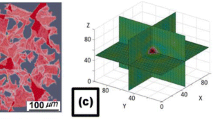Abstract
Background:
In synchrotron radiation computed tomography (SR-CT) of mechanical loading process, accurate reconstruction of finite angle projection information shielded by mechanical loading devices is a bottleneck problem.
Objective:
For accurate characterization, an experimental strategy for in situ SR-CT mechanical loading test was proposed in this manuscript, which was called "finite angle CT reconstruction method based on tilted sampling information recovery" or TSIR-CT.
Methods:
Effectively recovering the information lost in finite angle CT is a fundamental solution. From the new perspective of the frequency domain, the tilt sampled projection information was utilized to recover the missing angle information.
Results:
A series of numerical reconstruction experiments were carried out to verify the new method. It was indicated that the reconstruction results of TSIR-CT method have been improved quantitatively comparing with filtered back projection (FBP) and algebraic reconstruction technique (ART) method. For the 506th layer from top end of the 3D test model, the standardized covariance criterion for evaluating similarity was increased from 0.8400 of FBP and 0.9148 of ART to 0.9357, respectively. Finally, this new method was validated using actual SR-CT data and demonstrated effective improvement of reconstruction quality.
Conclusions:
This new method is suitable for in situ SR-CT mechanical loading test.









Similar content being viewed by others
References
Böhm R, Stiller J, Behnisch T et al (2015) A quantitative comparison of the capabilities of in situ computed tomography and conventional computed tomography for damage analysis of composites. Compos Sci Technol 110:62–68
Preuss M, Rauchs G, Doel TJA et al (2003) Measurements of fibre bridging during fatigue crack growth in Ti/SiC fibre metal matrix composites. Acta Mater 51:1045–1057
Wu SC, Xiao TQ, Withers PJ (2017) The imaging of failure in structural materials by synchrotron radiation X-ray microtomography. Eng Fract Mech 182:127–156
Pottmeyer F, Bittner J, Pinter P et al (2017) In situ CT Damage Analysis of Metal Inserts Embedded in Carbon Fiber-Reinforced Plastics. Exp Mech 57:1411–1422
Buffiere J, Proudhon H, Ferrie E et al (2005) Three dimensional imaging of damage in structural materials using high resolution micro-tomography. Nucl Instrum Methods Phys Res 238:75–82
Filippo Z, Elia S, Simone C et al (2018) X-ray computed tomography for metal additive manufacturing: challenges and solutions for accuracy enhancement. Procedia CIRP on SciVerse ScienceDirect 75:114–118
Elliott JC, Dover SD (2011) X-ray microtomography. J Microsc 126(Pt 2):211–213
Scott AE, Mavrogordato M, Wright P et al (2011) In situ fibre fracture measurement in carbon–epoxy laminates using high resolution computed tomography. Compos Sci Technol 71:1471–1477
Xu F, Niu Y, Hu XF et al (2014) Role of second phase powders on microstructural evolution during sintering. Exp Mech 54:57–62
Hruby P, Singh SS, Williams JJ et al (2014) Fatigue crack growth in SiC particle reinforced Al alloy matrix composites at high and low R-ratios by in situ X-ray synchrotron tomography. Int J Fatigue 68:136–143
Tuy HK (1983) An inversion-formula for cone-beam reconstruction. SIAM J Appl Math 43:546–552
Smith BD (1985) Image-reconstruction from cone-beam projections - necessary and sufficient conditions and reconstruction methods. IEEE Trans Med Imaging 4:14–25
Salomon BG, Ur H (2004) Accelerated Iterative Band-Limited Extrapolation Algorithms. IEEE Signal Process Lett 11:871–874
Zhang WK, Zhang HM, Wang LY et al (2018) Limited angle CT reconstruction by simultaneous spatial and Radon domain regularization based on TV and data-driven tight frame. Nucl Instrum Methods Phys Res, Sect A 880:107–117
Shepp LA, Logan BF (1974) The Fourier Reconstruction of a Head Section. IEEE Trans Nuclear Sci NS21:21–43
Xu F, Dong B, Hu XF et al (2017) In situ investigation on rapid microstructure evolution in extreme complex environment by developing a new AFBP-TVM sparse tomography algorithm from original CS-XPCMT. Opt Lasers Eng 96:124–131
Chen GH, Leng S et al (2005) A novel extension of the parallel-beam projection-slicce theorem to divergent fan-beam and cone-beam projections. Med Phys 32:654–665
Yuan C, Chen Z, Qi H et al (2018) CT image reconstruction for defective detector based on ART-TV algorithm. Med Phys 45:E396–E396
Helfen L, Baumbach T, Mikulik P et al (2005) High-resolution three-dimensional imaging of flat objects by synchrotron-radiation computed laminography. Appl Phys Lett 86:071915
Xiao Y, Xu F, Shen K et al (2018) A novel CT reconstruction algorithm for incomplete projection based on information repairment. Opt Lasers Eng 107:207–213
Chambolle A, Lions PL (1997) Image recovery via total variation minimization and related problems. Numer Math 76:167–188
Acknowledgements
This paper was supported by the National Key Research and Development Program of China (No.2017YFB0702000), National Nature Science Foundation of China (No.11722221, No. U1832216), Fundamental Research Funds for the Central Universities (WK2480000004). The authors greatly acknowledge Tiqiao Xiao, Honglan Xie, Guohao Du, Yanan Fu at SSRF for their valuable contribution to this work.
Author information
Authors and Affiliations
Corresponding author
Ethics declarations
Research Involving Human and Animal Participation
This research did not involve any human participants and/or animals.
Conflict of Interests
We declare that we have no conflict of interest with other people or organizations.
Additional information
Publisher's Note
Springer Nature remains neutral with regard to jurisdictional claims in published maps and institutional affiliations.
Rights and permissions
About this article
Cite this article
Li, J.W., Xiao, Y., Xu, F. et al. A Novel Experimental Strategy for In situ SR-CT Mechanical Loading Test. Exp Mech 61, 1217–1226 (2021). https://doi.org/10.1007/s11340-021-00707-8
Received:
Accepted:
Published:
Issue Date:
DOI: https://doi.org/10.1007/s11340-021-00707-8




